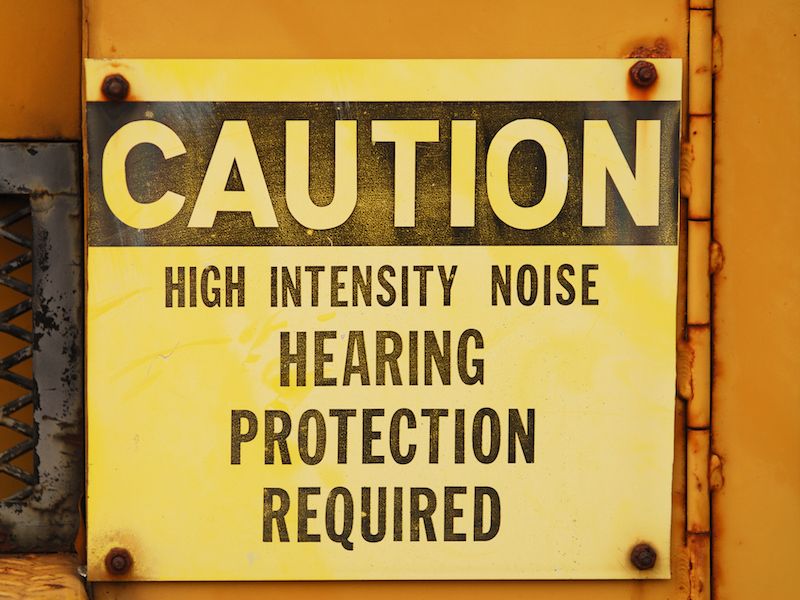
It’s one thing to realize that you need to protect your hearing. Knowing when to safeguard your ears is a different story. It’s not as simple as, for example, recognizing when to wear sunblock. (Are you going to go outside? Is the sun out? You should be wearing sunblock.) It’s not even as easy as recognizing when to wear eye protection (Working with hazardous chemicals? Doing some building? You need to wear eye protection).
With regards to when to use hearing protection, there seems to be a huge grey area which can be dangerous. Frequently, we’ll defer to our normal inclination to avoid hearing protection unless we’re given information that a specified activity or place is hazardous.
Risk Assessments
In general, we’re not very good at assessing risk, especially when it comes to something as intangible as injury to the ears or the probability of long term sensorineural hearing loss. To prove the point, check out some examples:
- Person A goes to a very loud rock concert. 3 hours is approximately how long the concert lasts.
- A landscaping business is run by person B. She spends a significant amount of time mowing lawns, then goes home to a quiet house and reads.
- Person C works in an office.
You might presume that person A (let’s call her Ann, to be a little less formal) might be in more hearing danger. Ann leaves the performance with her ears ringing, and she’ll spend the majority of the next day, struggling to hear herself talk. It seems reasonable to presume that Ann’s activity was rather risky.
The noise that person B (let’s just call her Betty), is exposed to is not as loud. Her ears don’t ring. So her hearing must be less hazardous, right? Well, not quite. Because Betty is mowing every day. So although her ears don’t ring out with pain, the injury builds up slowly. Even moderate noise, if experienced regularly, can harm your hearing.
Person C (let’s call her Chris) is even less clear. Lawnmowers come with instructions that indicate the dangers of ongoing exposure to noise. But even though Chris has a relatively quiet job, her long morning commute through the city every day is rather loud. What’s more, she sits at her desk and listens to music through earbuds. Does she need to think about protection?
When is it Time to be Concerned About Safeguarding Your Hearing?
The general guideline is that if you have to raise your voice in order to be heard, your surroundings are loud enough to do injure to your ears. And if your surroundings are that loud, you should think about wearing earmuffs or earplugs.
So to put this a little more scientifically, you should use 85dB as your cutoff. Sounds above 85dB have the capacity, over time, to cause injury, so in those circumstances, you need to consider wearing ear protection.
Your ears don’t have a built-in decibel meter to alert you when you reach that 85dB level, so countless hearing specialists suggest downloading specialized apps for your phone. You will be able to take the required steps to safeguard your ears because these apps will inform you when the noise is getting to a harmful volume.
A Few Examples
Your phone may not be with you anywhere you go even if you do download the app. So we might formulate a good standard with a few examples of when to safeguard our ears. Here we go:
- Using Power Tools: You recognize you will want hearing protection if you work all day in a factory. But what if you’re simply puttering around your garage all day? Most hearing professionals will recommend you wear hearing protection when using power tools, even if it’s only on a hobbyist level.
- Commuting and Driving: Spending all day as an Uber or Lyft driver? Or perhaps you’re taking the subway after waiting for a while downtown. The noise of living in the city is bad enough for your hearing, not to mention the extra damage caused by cranking up your tunes to drown out the city noise.
- Exercise: You know your morning spin class? Or even your nighttime yoga session? All of these cases might require ear protection. Those instructors who make use of microphones and sound systems (and loud music) to motivate you might be good for your heart rate, but all that volume is bad for your ears.
- Every day Chores: Even mowing a lawn, as previously stated, requires hearing protection. Chores, including mowing, are probably something you don’t even think about, but they can result in hearing impairment.
- Listening to music with earbuds. OK, this doesn’t require protection but does require caution. Whether your music is going directly into your ears, how loud it is playing, and how long you’re listening to it are all things you should give consideration to. Consider using headphones that cancel out outside sound so you don’t need to turn up the volume to damaging levels.
These examples may give you a good baseline. When in doubt, though, you should defer to protection. In most cases, it’s better to over-protect your ears than to leave them subject to possible injury in the future. Protect today, hear tomorrow.
